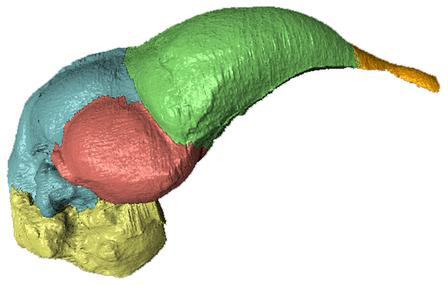Study of the Brains of Alligators and Birds Leads to the Inference that Dinosaurs were Capable of Complex Behaviours
Palaeontologists have got the bones of dinosaurs to study, but it is rare for any soft tissues of dinosaurs to be preserved in the fossil record. True, scars on bones can provide scientists with information on musculature and ligament placement but it is only through comparative analysis of animals alive today that any understanding of the layout, placement and size of organs of the Dinosauria can be deduced. For example, much work has been done regarding the study of dinosaur brains, even though no fossilised Dinosauria brain material is known from the fossil record.
Dinosaur Brain
Team members at Everything Dinosaur have been fortunate to work with endocasts of the brains of ancient reptiles. Endocasts are internal moulds of the brain cavity and other areas of the skull. By piecing the skull bones carefully together, scientists can work out the size, shape and volume of the spaces left inside. For example, the shape of some tyrannosaur brains have been calculated using this method. However, endocasts do not provide much information on the brain’s internal structures or what sort of behaviours dinosaurs were capable of.
Last month, Everything Dinosaur team members reported on the research being undertaken concerning an attempt to map the neural pathways and nerve structure of a Cambrian-aged arthropod fossil that had been discovered in China.
To read more about this research: Ancient Arthropod Brain and Nervous System Revealed.
New Study into the Brains of Dinosaurs
A new study, conducted by a team of international researchers at Duke University in North Carolina (USA), has enabled neuroscientists to create a detailed map of the brain of Theropod dinosaurs. From this work the team have deduced that these animals were capable of complex behaviours and perhaps even used sounds to communicate with each other just as some birds do today.
Were Dinosaurs Like T. rex Capable of Sophisticated Behaviours?
Picture credit: Everything Dinosaur
To view the Nanmu Studio Jurassic Series range of prehistoric animal models: Nanmu Studio Jurassic Studio Models and Figures.
Dr Erich Jarvis, a neuroscientist and one who specialises in looking at how brain function can help vocalisation and learning commented:
“In the popular mind, dinosaurs may be underrated in the complexity of their behaviour.”
For Dr Jarvis, a lead author of the dinosaur brain study that has just been presented at the Society of Neuroscience meeting in California , added that as soft tissues were rarely preserved in the Dinosauria and that fossilised brain material was unheard of then researchers had to infer dinosaur brain function and morphology by studying extant species that represent close relatives of the dinosaurs.
Capable of Complex Behaviours
Having conducted such a study on alligators and birds it can be inferred that dinosaurs were capable of complex behaviours with parts of the brain specialising in processing visual data, auditory information and assisting with vocalisation.
Asked to comment on the team’s findings, Dr Jarvis said that amongst other skills, dinosaurs had sufficient brain complexity to communicate with sounds but, “did it really happen? That we do not know.”
To gain an insight into how dinosaurs thought and communicated, the U.S. based research team studied the brains of alligators, as crocodilians are thought to be the most closely related to the dinosaurs of all the types of living reptile today. In addition, the scientists analysed the brains of birds.
Studying the Brains of Crocodilians and Birds
Birds are essentially avian dinosaurs, the Aves being very closely related to parts of the theropod group of the Dinosauria. From the work on extant creatures the team could piece together an approximation for a typical theropod dinosaur brain and infer its capabilities.
Using a technique that involves mapping gene activity in different parts of the brain as the animal is subjected to certain stimuli, the researchers were able to gain an insight into the function of alligator brains and those of birds. From this work the map of the dinosaur brain was re-created. Some genes are permanently on in the brain, whilst others are only switched on in response to certain stimuli, for example, some genes are only activated for a fraction of a second in response to sounds, particularly in that part of the brain associated with the hearing function and interpretation of sounds.
Examining the Auditory Regions of the Brain
To plot the auditory regions of the brain, Dr Jarvis and his team quietened the animals down in a darkened room and then played bird songs to birds and alligator calls to the alligators. The team then swiftly removed their brains, froze them, sliced them, and looked at the genes that had switched on in different regions. Naturally, this was what we palaeontologists term a “destructive” form of research, unfortunately the animals had to be killed before the second phase of the research could be undertaken.
The genetic data that had been retained in the brain slices enabled the research team to make highly detailed maps of the bird and the alligator brains. They could work out how the brain was organised and which parts had been stimulated by the earlier experiments. Using the bird and alligator models as templates, the researchers created an amalgam of the two to represent the brain of a typical theropod dinosaur using endocasts from Tyrannosaurus rex and a Late Jurassic theropod called Allosaurus fragilis. In addition, the bird brain of Archaeopteryx lithographica was re-created.
Six Distinct Regions Identified
The result of this research enabled the scientists to identify six distinct regions within the dinosaur’s brains and a similar structure in that of the early bird Archaeopteryx. One of these regions, called the mesopallium, would have been involved in processing complex data, given the Dinosauria the capacity for sophisticated behaviour.
An Endocast of the Brain of Archaeopteryx (A. lithographica)

The brain cast of Archaeopteryx lithographica, one of the earliest known birds, partitioned into neuroanatomical regions: brain stem (yellow), cerebellum (blue), optic lobes (red), cerebrum (green), and olfactory bulbs (orange).
Picture credit: AMNH/Dr. Balanoff
Dr Jarvis explained:
“It suggests that the dinosaur brain had the capacity for complex sensory motor processing, just like we see in birds and alligators.”
However, whilst a large number of today’s birds, the passerines (perching birds), have the ability to produce very complicated vocalisations and even learn shared “songs”. It can only be inferred that members of the Dinosauria were also able to do this as all the brain sub-divisions that support such vocal learning seem to present.
Dr Jarvis, went onto to state:
“We don’t have any evidence that there was a dinosaur out there that did this, that shared vocal learning with songbirds. But all the brain subdivisions to support vocal learning are there, so I’d argue the capacity to evolve vocal learning did exist in dinosaurs.”
Crocodiles have some of the most sophisticated and complex behaviours of all the reptiles known today. Certainly, male Alligators (Alligator mississippiensis) are capable of making very loud noises as they ward of rivals and call to attract a mate in the breeding season, perhaps Tyrannosaurus rex did something similar.






[…] bibs and bobs: Apparently, Scientists have created Detailed Map of the Dinosaur Brain according to Mike at the Everything Dinosaur […]